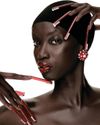
On the avenue today before The Metropolitan Museum of Art, it is frosty, with a selection of clothing that reflects the weather—pedestrians are hastening by with scarves and tweed coats drawn to their chins. But soon the rush of passing garments will change. In the spring, when the trees of Central Park grow fragrant and the asphalt warms, people wearing dresses in soft fabrics will pass scatterings of tourists out on the museum steps. At the start of May, a red carpet will draw up the staircase, and guests dressed for the Met Gala will catch camera flashes on their way inside. By tradition, that will be high fashion’s brightest moment, when an outfit and a personality bring each other most entirely to life. Then the attendees will enter the museum, where, most years, they would tour an exhibition of historic dresses whose wearers are long vanished, and whose fabrics are now frozen in place.
“It’s something we always struggle with—that, once a garment comes into the museum, a lot of the sensorial experiences that we take for granted with clothing are lost,” Andrew Bolton, the curator in charge at the Costume Institute, explains this morning, over tea, in a dimly lit conference room inside The Met. Photographs of more than 50 clothing items are pinned to the wall. “The positive part of it is that we’re custodians of the clothing, here to take care of it in perpetuity,” he goes on. “But that involves very specific conditions: You can’t touch it, you can’t smell it, it can’t be worn. And you can’t hear it.”
この記事は Vogue US の May 2024 版に掲載されています。
7 日間の Magzter GOLD 無料トライアルを開始して、何千もの厳選されたプレミアム ストーリー、9,000 以上の雑誌や新聞にアクセスしてください。
すでに購読者です ? サインイン
この記事は Vogue US の May 2024 版に掲載されています。
7 日間の Magzter GOLD 無料トライアルを開始して、何千もの厳選されたプレミアム ストーリー、9,000 以上の雑誌や新聞にアクセスしてください。
すでに購読者です? サインイン

FINAL CUT
\"WE WANT YOU TO GO FOR IT!\" ANNA TOLD ME

SCREEN TIME
Three films we can't wait to see.

Impossible Beauty
Sometimes, more is more: Surreal lashes and extreme nails put the fierce back in play

Blossoms Dearie
Dynamic, whimsical florals and the humble backdrops of upstate New York make for a charming study in contrasts.

HOME
Six years ago, Marc Jacobs got a call about a house designed by Frank Lloyd Wright. Making it his own, he writes, would be about love, commitment, anxiety, patience, struggle, and, finally, a kind of hard-fought, hard-won peace.

GIRL, INTERRUPTED
Anna Weyant found extraordinary fame as an artist before she had reached her mid-20s. Then came another kind of attention. Dodie Kazanjian meets the painter at the start of a fresh chapter

ROLE PLAY
Kaia Gerber is someone who likes to listen, learn, read books, go to the theater, ask questions, have difficult conversations, act, perform, transform, and stretch herself in everything she does. That she's an object of beauty is almost beside the point.

CALLAS SHEET
Maria Callas's singular voice made her a legend on the stage. In a new film starring Angelina Jolieand on the runwaysthe romance continues.

BOOK IT
A preview of the best fiction coming

GLOBAL VISTAS
Three new exhibitions offer an expansive view.